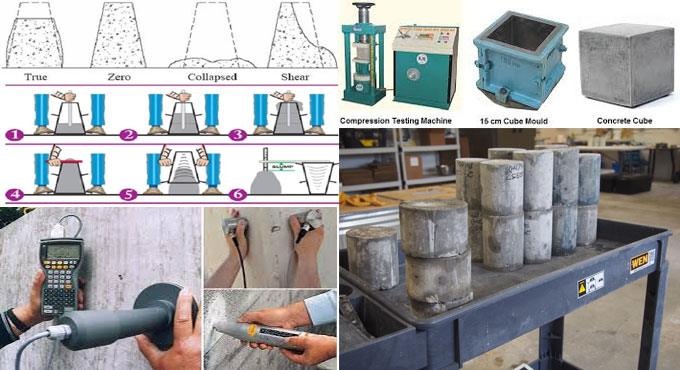Concrete is mainly a composite material that comprises of fine & coarse aggregate, water, cement, and admixtures.
To obtain high-quality concrete, the sample should be examined thoroughly to ensure whether it is formed according to requirement or not. If the test for concrete is not conducted, the following problems will occur :-
• Cracks and voids in the finished concrete.
• The concrete of Low compressive strength.
• Bleeding
Given below, the details on some vital tests of concrete:
1. Workability test
2. compressive strength test
3. Non-destructive test
4. Destructive test
5. Durability test
WORKABILITY TEST: Workability test plays a crucial role since it is associated with the strength of concrete. Workability means the capacity to fill the mould perfectly with the vibrator but the quality of concrete is not affected. The Workability of concrete is calculated with the following test:
• SLUMP TEST
• VEE-BEE TEST
• COMPACTING FACTOR TEST
Compressive strength of concrete: The concrete can’t sustain the compressive load. So, it becomes essential that any concrete member could withstand a good amount of compressive load.
Under this test, the maximum compressive strength of the concrete sample is ascertained after 28 days of curing. Based on the standard code of India, 150 mm concrete cubes are utilized in this test. Under this test, the concrete sample should be immersed for 28 days and after each 7 days water should be changed. After 28 days of curing, the concrete specimen is arranged on the machine plate.
Now load is provided slowly to the specimen unless the collapsing of the concrete cube occurs. Destructive and Non-destructive Test of Concrete These tests are carried out to find out the compressive strength of the existing concrete structure where the required concrete sample is not available.
This types of tests are conducted with the destructive or Non-destructive way.
If Non- destructive way is followed, compressive strength should be established devoid of affecting the structure or any concrete member. The Non-destructive test is conducted on the following ways :
• Rebound hammer test
• Penetration and pullout techniques
• Surface hardness test
• Radio-active method
Most common Destructive tests are as follows:
• Concrete core test
• Cube test
• Tensile strength test
Durability Test: With the purpose of maintaining the sustainability of concrete, the stability of concrete is required. To enhance the stability of concrete, it's vital that concrete should contain the following qualities :
• Water resistance
• Chloride attack resistance
• Resistance to infiltration of water.
Read more

~~~~~~~~~~~~~~~~~~~~~~~~
Published By
Rajib Dey
www.constructioncost.co
~~~~~~~~~~~~~~~~~~~~~~~~
To obtain high-quality concrete, the sample should be examined thoroughly to ensure whether it is formed according to requirement or not. If the test for concrete is not conducted, the following problems will occur :-
• Cracks and voids in the finished concrete.
• The concrete of Low compressive strength.
• Bleeding
Given below, the details on some vital tests of concrete:
1. Workability test
2. compressive strength test
3. Non-destructive test
4. Destructive test
5. Durability test
WORKABILITY TEST: Workability test plays a crucial role since it is associated with the strength of concrete. Workability means the capacity to fill the mould perfectly with the vibrator but the quality of concrete is not affected. The Workability of concrete is calculated with the following test:
• SLUMP TEST
• VEE-BEE TEST
• COMPACTING FACTOR TEST
Compressive strength of concrete: The concrete can’t sustain the compressive load. So, it becomes essential that any concrete member could withstand a good amount of compressive load.
Under this test, the maximum compressive strength of the concrete sample is ascertained after 28 days of curing. Based on the standard code of India, 150 mm concrete cubes are utilized in this test. Under this test, the concrete sample should be immersed for 28 days and after each 7 days water should be changed. After 28 days of curing, the concrete specimen is arranged on the machine plate.
Now load is provided slowly to the specimen unless the collapsing of the concrete cube occurs. Destructive and Non-destructive Test of Concrete These tests are carried out to find out the compressive strength of the existing concrete structure where the required concrete sample is not available.
This types of tests are conducted with the destructive or Non-destructive way.
If Non- destructive way is followed, compressive strength should be established devoid of affecting the structure or any concrete member. The Non-destructive test is conducted on the following ways :
• Rebound hammer test
• Penetration and pullout techniques
• Surface hardness test
• Radio-active method
Most common Destructive tests are as follows:
• Concrete core test
• Cube test
• Tensile strength test
Durability Test: With the purpose of maintaining the sustainability of concrete, the stability of concrete is required. To enhance the stability of concrete, it's vital that concrete should contain the following qualities :
• Water resistance
• Chloride attack resistance
• Resistance to infiltration of water.
Read more

~~~~~~~~~~~~~~~~~~~~~~~~
Published By
Rajib Dey
www.constructioncost.co
~~~~~~~~~~~~~~~~~~~~~~~~
